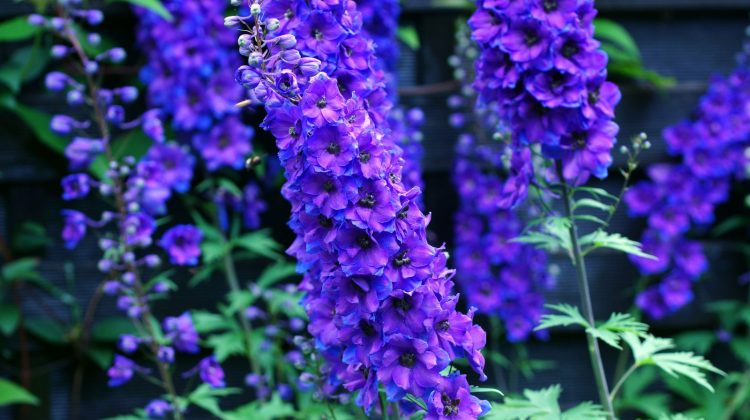
Delphiniums are a stunning addition to any garden, with their striking spires of colorful flowers that range from deep blues to vibrant pinks.
Known for their impressive height and elegant foliage, these perennials can add both height and charm to your flower beds.
If you’re looking to add a touch of drama to your garden landscape, growing delphiniums is a rewarding pursuit.
Getting started with delphiniums may seem daunting due to their seemingly delicate nature, but with the right conditions and care, they can flourish.
These flowers prefer cooler climates and fare best with full to part sun exposure and well-draining soil with a pH ideally between 6 and 7.5.
Providing consistent moisture without allowing the soil to dry out will keep your delphiniums happy.
Proper planting and care are crucial for these beauties to thrive.
Begin by selecting a spot in your garden that receives the right amount of sunlight and has the appropriate soil conditions.
You’ll learn how smoothing the soil, adequate spacing, and regular maintenance can lead to lush, vibrant delphiniums that will be the envy of your neighborhood.
With a little patience and following the right steps, your garden will soon be adorned with these majestic flowers.
In this article, we'll cover
1. Planning Your Delphinium Garden
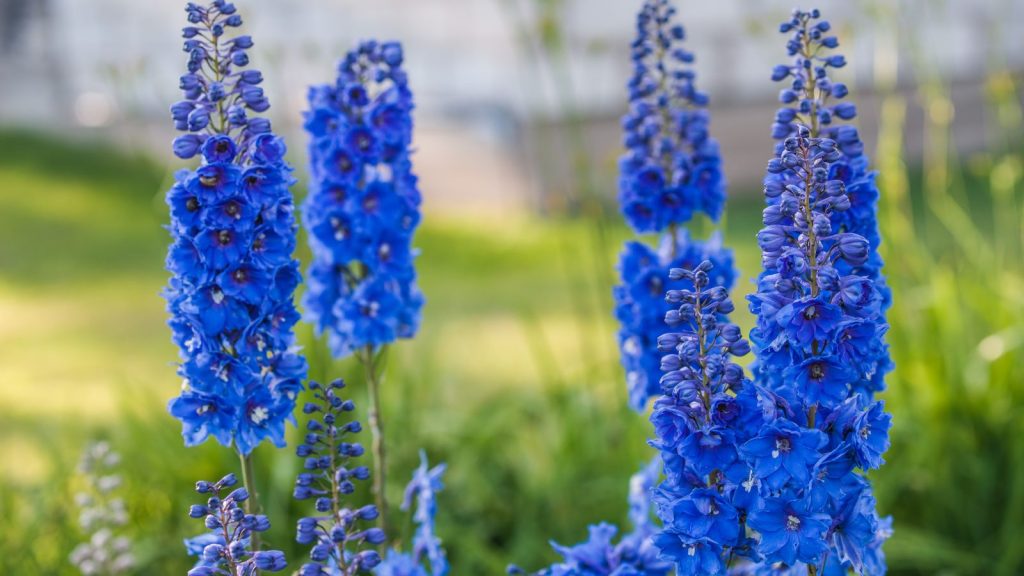
Before you dive into the rewarding journey of growing delphiniums, consider the location, variety selection, and soil requirements. Each factor plays a crucial role in nurturing these stately blooms to their full potential.
Choosing the Right Location
Your delphiniums will thrive in a location that receives full sun to light shade. Aim for a spot that gets at least 6 hours of sunlight daily.
Keep in mind that while they prefer cooler temperatures, delphiniums are adaptable to a range of climates but may struggle in intense heat. Ensure protection from strong winds as their tall stalks can be quite fragile.
Selecting Delphinium Varieties
When choosing delphinium varieties, you’re spoiled for choice with colors ranging from stunning purple and blue to gentle pink, white, yellow, and even red.
The Magic Fountain series is perfect if you’re looking for a compact plant, typically staying below 3 feet in height.
For a dramatic touch, consider the imposing elatum group or the renowned Pacific hybrids, which can soar up to 6 feet tall.
The belladonna group offers beautiful branching flower spikes for a more casual appearance in your garden.
Understanding Soil Requirements
Delphiniums demand well-draining soil to prevent root rot. Ideal soil pH is slightly alkaline, between 6.0 and 7.5.
Enrich the planting area with compost to provide the nutrients your delphiniums will love.
Regular watering is key, but it’s crucial to ensure the soil doesn’t become waterlogged, especially during cooler weather when soil takes longer to dry out.
2. Planting Delphiniums
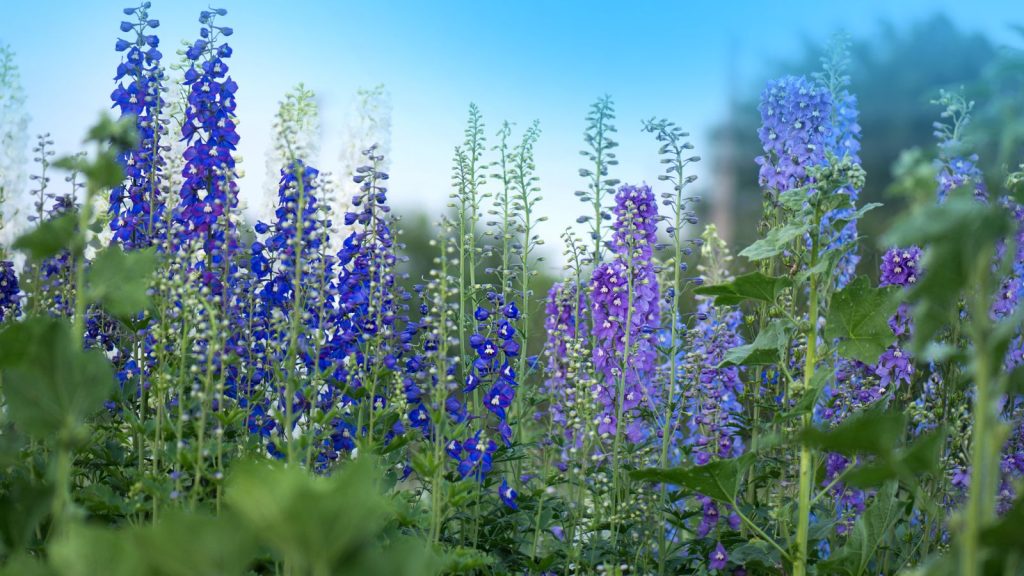
When planting delphiniums, the journey begins with the tiny seed and evolves through careful sowing, transplanting, and mindful spacing to ensure your garden is graced with their majestic spires.
Sowing Delphinium Seeds
To successfully grow delphiniums from seeds, your initial step is to start them in a seed tray.
Choose a period between February and June or in the cooler months of September or October to sow your delphinium seeds.
Before planting, expose the seeds to cold by refrigerating them, which is essential to stimulate germination.
Use a seed tray filled with warm, moist potting compost and cover the seeds lightly with soil.
Keep the soil moist but not waterlogged to promote optimal soil moisture for the seeds to sprout.
Transplanting Seedlings
Once your delphinium seedlings emerge, which should happen in about 14 to 21 days, you’ll prepare for the next stage: transplanting.
When the seedlings have grown enough to handle, typically when they have their first set of true leaves, delicately transplant the seedlings into individual pots filled with a mix of soil and compost.
At this point, ensure they have sufficient light and keep the soil consistently moist.
To prevent shock, harden off the plants by gradually introducing them to outdoor conditions over a week before planting them out.
Spacing and Arrangement in Beds
Delphiniums thrive when they have room to grow, both for their roots to spread out and for air to circulate between plants, reducing the risk of disease.
As you arrange the delphiniums in your garden beds, space the transplanted seedlings about 12 to 18 inches apart to give each plant adequate room to mature.
Place them in well-draining soil with a pH range of 6 to 7.5, and consider their hardiness zone, ensuring it matches the climatic conditions of your area.
For both aesthetic appeal and healthy growth, mingle your delphiniums with other garden plants, balancing annuals, biennials, and perennials for a continuous bloom.
3. Delphinium Care and Maintenance
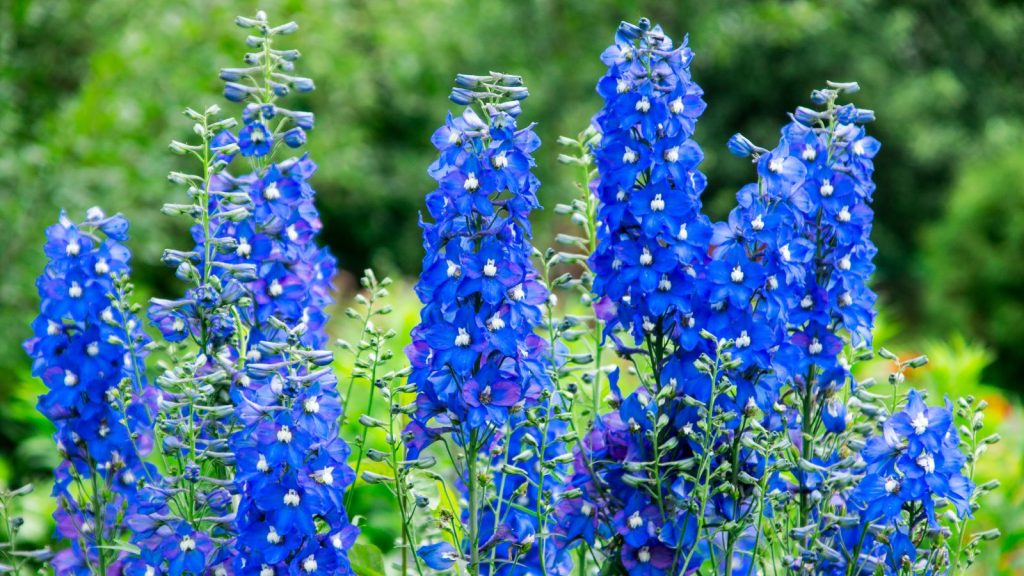
Delphiniums bring vibrant color and height to your garden, attracting pollinators like hummingbirds, bees, and butterflies. Proper care ensures these majestic plants remain healthy and produce striking blooms season after season.
Watering and Moisture Management
Delphiniums require consistently moist soil, but it’s crucial to avoid waterlogging which can lead to root rot.
Ensure your soil is well-draining and enrich it with organic matter to maintain the ideal moisture balance.
Apply a layer of mulch to keep the roots cool and moist during hot spells.
During the growing season, water your delphiniums deeply once a week, increasing frequency during periods of drought.
Supporting Tall Varieties
Staking is essential for tall delphinium varieties to prevent their hollow stems from snapping.
Insert bamboo stakes early in the season when the plant is about 12 inches high.
Use garden twine to tie the stems to the stakes gently, providing support as they grow. Creating a grid with string can also provide a supportive framework for the plants.
Managing Pests and Diseases
Delphiniums can be susceptible to pests like slugs and diseases such as powdery mildew and black blotch.
Regularly inspect your plants and use organic methods to control pests; handpick slugs during the evening or use diatomaceous earth.
For diseases like powdery mildew, improve air circulation around your plants and apply a fungicidal spray if necessary.
Avoid overhead watering which can exacerbate leaf diseases, and remove affected parts promptly to prevent the spread.
Keep the area around your delphiniums clean to minimize the potential of disease and pest infestation.
4. Enhancing Blooming and Aesthetics
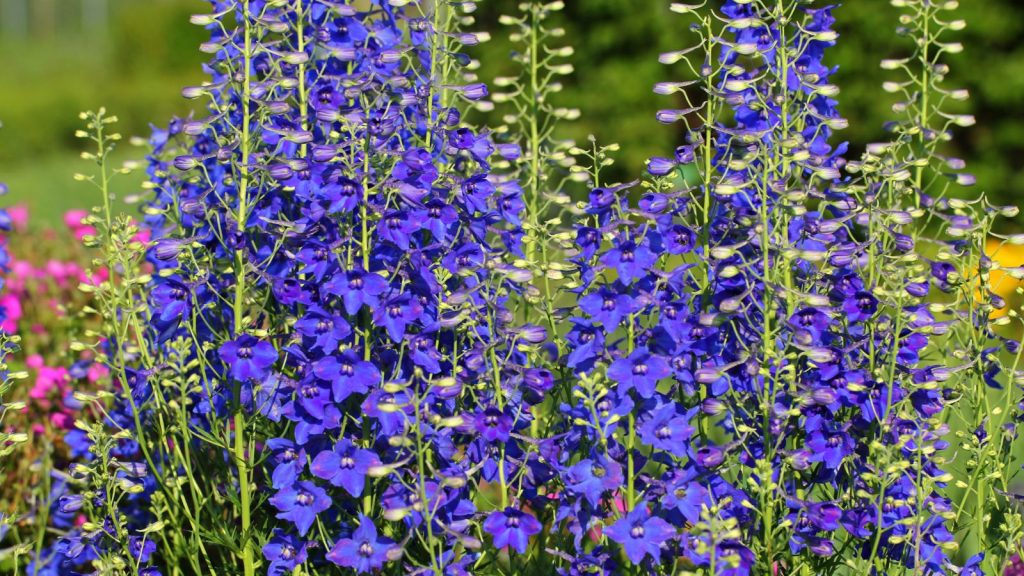
To ensure your delphiniums reach their full potential, focusing on proper fertilization, timely pruning, and managing the plant’s vibrant colors and spread is essential.
Fertilization and Soil Amendments
To promote healthy blooming, fertilization is key.
Apply a balanced fertilizer in the spring as your delphiniums start to grow.
Additionally, incorporating well-rotted manure into the soil can provide essential nutrients to help your flowers thrive.
For containers, a controlled-release fertilizer can be more convenient, ensuring your plant has a steady nutrient supply.
- Spring: Apply balanced fertilizer
- Soil Amendment: Mix in well-rotted manure
Pruning and Deadheading Practices
Regular pruning and deadheading will encourage your delphiniums to bloom more vigorously.
Once the main flower stalk has finished blooming, cut it back to encourage side shoots to flower.
Removing spent flowers, a practice known as deadheading, not only improves the plant’s appearance but can also promote a second blooming period.
- Pruning: Cut back main flower stalk after blooming
- Deadheading: Remove spent flowers to encourage further blooming
Managing Flower Colors and Spread
Delphiniums are available in a range of colors, and maintaining the vibrancy of these hues is essential for a stunning display.
Mulching can help retain moisture and keep roots cool, which is crucial for vibrant colors.
To manage the spread and support tall stalks, use stakes as needed.
Ensure you’re spacing your delphiniums adequately; crowded plants can lead to poor air circulation and diminished blooming.
5. Preparing for Seasonal Changes
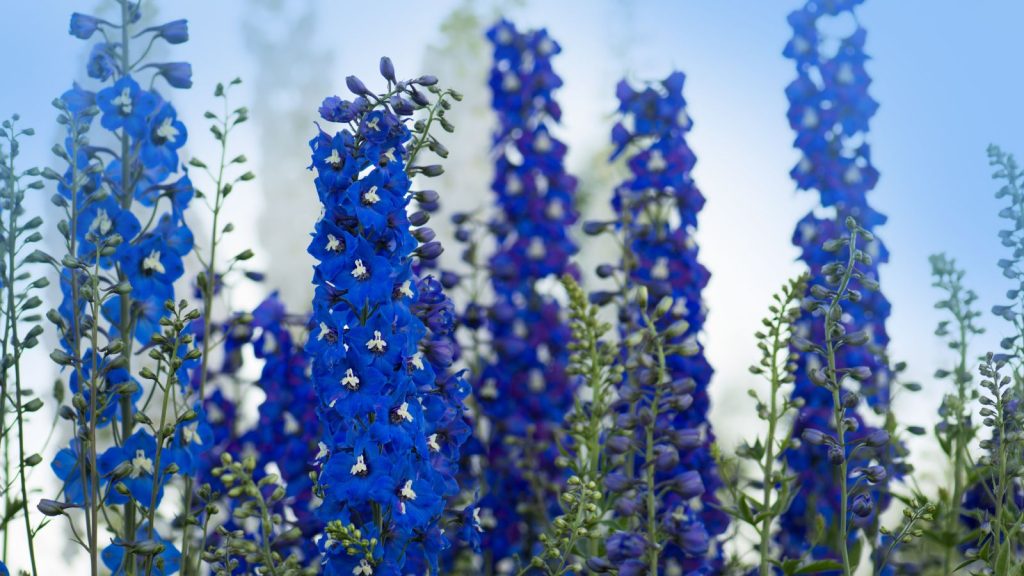
Delphiniums thrive with proper seasonal care, making your cottage garden vivid throughout the year. You must adjust gardening practices for these beauties of the buttercup family as temperatures dip and rise to maintain their splendor.
Overwintering Delphiniums
Delphiniums require a bit of attention to survive the cold winter.
Begin by cutting back the plant’s foliage to the ground after the first frost.
Apply a layer of mulch around the base to provide insulation against freezing temperatures.
Preferably, choose organic mulch like straw or leaves as it will enrich the well-drained soil as it decomposes when spring arrives.
Adjusting Care for Summer Heat
In areas of intense summer heat, delphiniums may need a little extra TLC.
Provide partial shade during the hottest parts of the day to protect them from scorching sunlight.
Ensure they are in a sheltered location, away from strong winds that could damage their tall stems.
Consistent watering is key in summer; keep the soil evenly moist but avoid waterlogging.